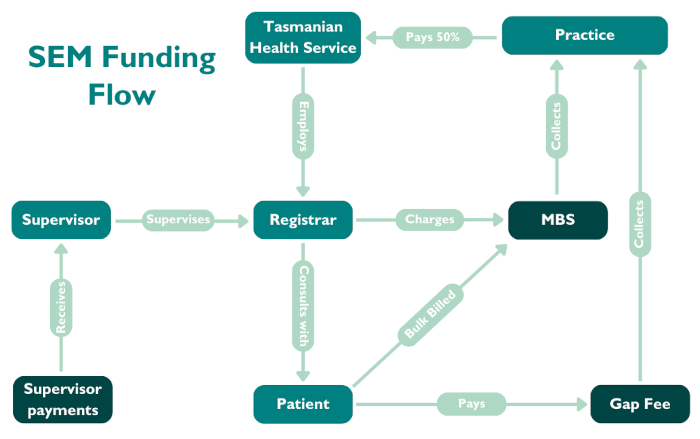Single Employer Model Pilot
The Single Employer Model (SEM) pilot in Tasmania is a collaborative project of the Australian Government and State Government. It is the first state-wide program available to any GP registrar in a MMM2-7 area. The Australian Government is contributing $7.97 million through the Primary Care Initiative as well as eighty 19(2) exemptions for Department of Health employed GP registrars practicing in private general practice. The State Government is contributing through the Rural Medical Workforce Centre, including $1 Million of operational costs per annum ongoing.
Participation in the SEM pilot is optional, and upon mutual agreement with their practice, registrars can choose to leave the SEM at any time. Once they have left the SEM, they will not be eligible to re-enter. Currently, lateral entry into the pilot is possible.
SEM Billings
Registrars participating in the SEM pilot consult and bill patients as per normal however will receive a salary instead of a percentage of their billings. Their billings will be collected by the practice and split between the THS and their practice, with each party receiving 50% as per a THS/Medical Centre Agreement. The 50% received by the THS assists to pay the registrars salary while the 50% received by the practice will go towards administrative costs of hosting a trainee at the practice.

The Supervisor receives a supervisor payment and supervises the registrar. The registrar consults with patients and charges the MBS. The patient is either bulk billed through MBS or pays a gap fee. The practice collects all the registrar billings and then pays 50% of this to the Tasmanian Health Service (THS). The THS employs the registrar and is responsible for paying the registrars salary.
Training
The SEM pilot does not intend to interfere with the training requirements of doctors.
For interns and Resident Medical Officers, this is monitored by the Postgraduate Medical Council of Tasmania (PMCT).
For registrars, training standards are set by the GP colleges – either the Royal Australian College of General Practitioners (RACGP) or the Australian College of Rural and Remote Medicine (ACRRM).
The pathways to Fellowship of either college are complex and include Australian Government supported training pathways and independently financed pathways. Training programs may include the Australian General Practice Training (AGPT) program, the Remote Vocational Training Scheme – including the Targeted Recruitment Scheme, the ACRRM Independent Pathway, the Rural Generalist Training Scheme, and the RACGP Fellowship Support Program.
To support the training requirements of Single Employer Model participants:
- All intern and RMO rotations in rural primary care will be accredited with the PMCT.
- All GP registrar rotations will be accredited with the relevant college, noting that in Tasmania the colleges are working together on dual accreditation of practices.
Employment
When entering the SEM, registrars are choosing to be employed by the Tasmanian Health Department, on behalf of the Department of Health, under the Salaried Medical Professional Agreement (SMPA). Registrars participating in SEM have the flexibility to work in private practice and across multiple sites while remaining a THS employee. This means GP registrars will have the same entitlements as their hospital-based peers such as annual, sick, and maternity leave and a salary while they complete their General Practice training.
Registrars will need to secure a training placement at an accredited GP training practice that is listed on the current 19(2) direction. Tasmanian Aboriginal Heatlh Services do not need to be listed if they already have their own 19(2) direction in place. Upon entering a THS/Medical Centre agreement, they can still host registrars who are employed under the SEM.
Definitions of full-time training may differ to definitions of full-time employment under the SMPA.
Recruitment
Throughout the year, there will be two extended recruitment rounds for registrars to apply to participate in SEM. This process will require doctors to submit their CV and cover letter outlining their reasons for wanting to participate in the SEM pilot. They will then be subject to the selection process. During this process, the registrar will need to confirm their rostered hours, locations and on call.
These recruitment rounds will open in approximately September and again in April. This will allow registrars to enter the program laterally, during the recruitment periods, and at the beginning of each training period. Appointment of the roles will not need to wait until the closure of the round, unless there are more applications for the role than there are positions available.
Registrars can choose to leave the SEM at any time, upon agreement with their practice. Once a registrar leaves the SEM, they will not be eligible to re-enter at any time.
19(2) Direction
Section 19(2) of the health Insurance Act, 1973 precludes state-employed medical practitioners utilising Medicare Benefits for non-admitted, non-referred professional services unless an exemption applies. The Tasmanian Department of Health has a Memorandum of Understanding with the Commonwealth Government that enables participants on the Single Employer Model pilot to utilise a 19(2) exemption. This means GP registrars participating in the Single Employer Model pilot will be employed by the State Service and Medicare Benefits will still be applicable to the services they provide.
The 19(2) direction is updated every 12 months. Around early September each year the expression of interest (EOI) process will open for practices to register their interest to be listed on the 19(2) direction for the following year. Practices who register are not guaranteed to have a registrar placed at the practice, rather they are committing to be listed as a possible site able to use a 19(2) exemption.
Practice Eligibility
Any practice (MMM2-7) that has accreditation for GP training, a willing supervisor participant and a willing registrar participant. Preference will be given to remote/rural areas and those serving vulnerable populations.
Useful Links
For more information, please check out the above documents or email the team at tasrural.pathways@health.tas.gov.au

